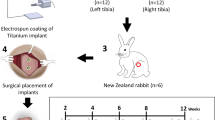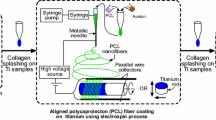Abstract
The growing incidence of bone injuries has elevated the demand for Titanium-based orthopedic implants, yet implant-associated infections and loosening remain significant contributors to implant failure in orthopedic surgeries. The present study addressed the issue of aseptic and septic loosening of Ti–6Al–4V orthopedic implants using a bidirectional strategy of develo** extracellular matrix (ECM) mimicking electrospun nanofiber coating composed of polyvinyl alcohol (PVA)–Gelatin–Quercetin (PGQ) with concomitant antibacterial and osteoinductive property on Ti–6Al–4V surface. The polymeric nanofiber coating of PVA–Gelatin (PG) blend on the Ti–6Al–4V showed ECM mimicking morphology confirmed by SEM with desirable strong adhesion in accordance with ASTM D3359:3B over the implant surface. The physiochemical characterizations of the coated nanofibers performed by FTIR and contact angle measurement confirmed presence of hydrophilic PG coating on Ti–6Al–4V surface. Reinforcement of Quercetin, a natural polyphenol with promising antibacterial and osteogenic potential in PG nanofibers and coating on Ti–6Al–4V imparted antibacterial and osteogenic properties. Quercetin-loaded PGQ nanofibers showed a biphasic release pattern with initial burst release of Quercetin from the implant surface providing the required protection with early microbial infections from Staphylococcus aureus (S. aureus), whereas steady controlled release of Quercetin from Ti-PGQ implant supported alkaline phosphatase (ALP) activity and Ca–P mineral deposition by osteoblast. The Quercetin concentration of 0.1% (w/v) showed the overall optimum cellular response compared to 0.05 and 0.2% concentration. These findings reflect substantial progress in employing Quercetin-loaded nanofiber-coated Ti–6Al–4V to potentially lower aseptic and septic loosening risks in bone tissue engineering.
Graphical abstract







Similar content being viewed by others
Availability of data and materials
The datasets generated during and/or analyzed during the current study are available from the corresponding author on reasonable request.
References
Stewart C, Akhavan B, Wise SG, Bilek MMM (2019) A review of biomimetic surface functionalization for bone-integrating orthopedic implants: mechanisms, current approaches, and future directions. Prog Mater Sci 106:100588
Kiran ASK, Kumar TS, Perumal G, Sanghavi R, Doble M, Ramakrishna S (2018) Dual nanofibrous bioactive coating and antimicrobial surface treatment for infection resistant titanium implants. Prog Org Coat 121:112–119
Wang Z, Wang X, Wang Y, Zhu Y, Liu X, Zhou Q (2021) NanoZnO-modified titanium implants for enhanced anti-bacterial activity, osteogenesis and corrosion resistance. J Nanobiotechnol 19:1–23
Yuan Z, He Y, Lin C, Liu P, Cai K (2021) Antibacterial surface design of biomedical titanium materials for orthopedic applications. J Mater Sci Technol 78:51–67
Hodges NA, Sussman EM, Stegemann JP (2021) Aseptic and septic prosthetic joint loosening: Impact of biomaterial wear on immune cell function, inflammation, and infection. Biomaterials 278:121127
Sloan M, Premkumar A, Sheth NP (2018) Projected volume of primary total joint arthroplasty in the US, 2014 to 2030. JBJS 100:1455–1460
Prieto HA, Berbari EF, Sierra RJ (2014) Acute delayed infection: increased risk in failed metal on metal total hip arthroplasty. J Arthroplasty 29:1808–1812
Das S, Dholam K, Gurav S, Bendale K, Ingle A, Mohanty B, Chaudhari P, Bellare JR (2019) Accentuated osseointegration in osteogenic nanofibrous coated titanium implants. Sci Rep 9:1–14
Dehnavi SM, Barjasteh M, Seyedkhani SA, Rahnamaee SY, Bagheri R (2023) A novel silver-based metal-organic framework incorporated into nanofibrous chitosan coatings for bone tissue implants. Int J Pharm 640:123047
Kiran ASK, Kizhakeyil A, Ramalingam R, Verma NK, Lakshminarayanan R, Kumar TS, Doble M, Ramakrishna S (2019) Drug loaded electrospun polymer/ceramic composite nanofibrous coatings on titanium for implant related infections. Ceram Int 45:18710–18720
Zhang L, Yan J, Yin Z, Tang C, Guo Y, Li D, Wei B, Xu Y, Gu Q, Wang L (2014) Electrospun vancomycin-loaded coating on titanium implants for the prevention of implant-associated infections. Int J Nanomed 9:3027
Keceli HG, Bayram C, Celik E, Ercan N, Demirbilek M, Nohutcu RM (2020) Dual delivery of platelet-derived growth factor and bone morphogenetic factor-6 on titanium surface to enhance the early period of implant osseointegration. J Periodontal Res 55:694–704
Samadian H, Khastar H, Ehterami A, Salehi M (2021) Bioengineered 3D nanocomposite based on gold nanoparticles and gelatin nanofibers for bone regeneration: In vitro and in vivo study. Sci Rep 11:1–11
Yang C, Wu X, Zhao Y, Xu L, Wei S (2011) Nanofibrous scaffold prepared by electrospinning of poly (vinyl alcohol)/gelatin aqueous solutions. J Appl Polym Sci 121:3047–3055
Gu S-Y, Wang Z-M, Ren J, Zhang C-Y (2009) Electrospinning of gelatin and gelatin/poly (l-lactide) blend and its characteristics for wound dressing. Mater Sci Eng, C 29:1822–1828
Huang C-Y, Hu K-H, Wei Z-H (2016) Comparison of cell behavior on pva/pva-gelatin electrospun nanofibers with random and aligned configuration. Sci Rep 6:37960
Rajabi T, Naffakh-Moosavy H, Bagheri F, Sadrnezhaad SK, Pour HM (2023) Tailoring metallurgical and biological characteristics of Ti–6Al–4V alloy by synergetic application of Nd: YAG laser and drug-loaded electrospun PVA. J Market Res 24:3759–3771
Barik A, Chakravorty N (2019) Targeted drug delivery from titanium implants: a review of challenges and approaches. Trends Biomedical Res, pp 1–17.
Brooks BD, Sinclair KD, Davidoff SN, Lawson S, Williams AG, Coats B, Grainger DW, Brooks AE (2014) Molded polymer-coated composite bone void filler improves tobramycin controlled release kinetics. J Biomed Mater Res B Appl Biomater 102:1074–1083
Betts JW, Sharili AS, Phee LM, Wareham DW (2015) In vitro activity of epigallocatechin gallate and quercetin alone and in combination versus clinical isolates of methicillin-resistant Staphylococcus aureus. J Nat Prod 78:2145–2148
Song JE, Tripathy N, Lee DH, Park JH, Khang G (2018) Quercetin inlaid silk fibroin/hydroxyapatite scaffold promotes enhanced osteogenesis. ACS Appl Mater Interfaces 10:32955–32964
Linh NTB, Lee B-T (2012) Electrospinning of polyvinyl alcohol/gelatin nanofiber composites and cross-linking for bone tissue engineering application. J Biomater Appl 27:255–266
Lamolle SF, Monjo M, Rubert M, Haugen HJ, Lyngstadaas SP, Ellingsen JE (2009) The effect of hydrofluoric acid treatment of titanium surface on nanostructural and chemical changes and the growth of MC3T3-E1 cells. Biomaterials 30:736–742
Kichi MK, Torkaman R, Mohammadi H, Toutounchi A, Kharaziha M, Alihosseini F (2020) Electrochemical and in vitro bioactivity behavior of poly (ε-caprolactone)(PCL)-gelatin-forsterite nano coating on titanium for biomedical application. Mater Today Commun 24:101326
Rezk AI, Unnithan AR, Park CH, Kim CS (2018) Rational design of bone extracellular matrix mimicking tri-layered composite nanofibers for bone tissue regeneration. Chem Eng J 350:812–823
Singh AK, Pramanik K, Biswas A (2019) MgO enables enhanced bioactivity and antimicrobial activity of nano bioglass for bone tissue engineering application. Mater Technol 34:818–826
Kumar S, Chatterjee K (2015) Strontium eluting graphene hybrid nanoparticles augment osteogenesis in a 3D tissue scaffold. Nanoscale 7:2023–2033
Singh AK, Pramanik K (2023) Fabrication and investigation of physicochemical and biological properties of 3D printed sodium alginate-chitosan blend polyelectrolyte complex scaffold for bone tissue engineering application. J Appl Polym Sci 140:e53642
Maharjan B, Park J, Kaliannagounder VK, Awasthi GP, Joshi MK, Park CH, Kim CS (2021) Regenerated cellulose nanofiber reinforced chitosan hydrogel scaffolds for bone tissue engineering. Carbohyd Polym 251:117023
Safari B, Aghanejad A, Kadkhoda J, Aghazade M, Roshangar L, Davaran S (2022) Biofunctional phosphorylated magnetic scaffold for bone tissue engineering. Colloids Surf B 211:112284
Kuntzler SG, Costa JAV, de Morais MG (2018) Development of electrospun nanofibers containing chitosan/PEO blend and phenolic compounds with antibacterial activity. Int J Biol Macromol 117:800–806
Amer AA, Mohammed RS, Hussein Y, Ali AS, Khalil AA (2022) Development of lepidium sativum extracts/PVA electrospun nanofibers as wound healing dressing. ACS Omega 7:20683–20695
Fahami A, Fathi M (2018) Fabrication and characterization of novel nanofibers from cress seed mucilage for food applications. J Appl Polym Sci 135:45811
Ramalingam R, Dhand C, Leung CM, Ong ST, Annamalai SK, Kamruddin M, Verma NK, Ramakrishna S, Lakshminarayanan R, Arunachalam KD (2019) Antimicrobial properties and biocompatibility of electrospun poly-ε-caprolactone fibrous mats containing Gymnema sylvestre leaf extract. Mater Sci Eng C 98:503–514
Subramanian S, Karuppannan SK, Ramalingam R, Dowlath MJH, Khalith SM, Musthafa SA, Chitra V, Munuswamy-Ramanujam G, Arunachalam KD (2021) Effect of gamma sterilization on Gymnema sylvestre leaf extract fused polycaprolactone nanofiber for effective wound dressing applications. Mater Lett 300:130145
Ghosal K, Agatemor C, Špitálsky Z, Thomas S, Kny E (2019) Electrospinning tissue engineering and wound dressing scaffolds from polymer-titanium dioxide nanocomposites. Chem Eng J 358:1262–1278
Koosha M, Mirzadeh H (2015) Electrospinning, mechanical properties, and cell behavior study of chitosan/PVA nanofibers. J Biomed Mater Res Part A 103:3081–3093
Parin FN, Terzioğlu P, Sicak Y, Yildirim K, Öztürk M (2021) Pine honey-loaded electrospun poly (vinyl alcohol)/gelatin nanofibers with antioxidant properties. J Textile Inst 112:628–635
Refat MS, Hamza RZ, Adam AMA, Saad HA, Gobouri AA, Al-Harbi FS, Al-Salmi FA, Altalhi T, El-Megharbel SM (2021) Quercetin/Zinc complex and stem cells: a new drug therapy to ameliorate glycometabolic control and pulmonary dysfunction in diabetes mellitus: Structural characterization and genetic studies. PLoS ONE 16:e0246265
Aminian A, Shirzadi B, Azizi Z, Maedler K, Volkmann E, Hildebrand N, Maas M, Treccani L, Rezwan K (2016) Enhanced cell adhesion on bioinert ceramics mediated by the osteogenic cell membrane enzyme alkaline phosphatase. Mater Sci Eng C 69:184–194
Sasikumar Y, Indira K, Rajendran N (2019) Surface modification methods for titanium and its alloys and their corrosion behavior in biological environment: a review. J Bio- Tribo-Corros 5:1–25
Hanawa T (2019) Titanium–tissue interface reaction and its control with surface treatment. Front Bioeng Biotechnol 7:170
Wang C, Zhu K, Gao Y, Han S, Ju J, Ren T, Zhao X (2023) Multifunctional GO-based hydrogel coating on Ti-6Al-4V Alloy with enhanced bioactivity, anticorrosion and tribological properties against cortical bone. Tribol Int 184:108423
Kranthi Kiran AS, Kizhakeyil A, Ramalingam R, Verma NK, Lakshminarayanan R, Kumar TSS, Doble M, Ramakrishna S (2019) Drug loaded electrospun polymer/ceramic composite nanofibrous coatings on titanium for implant related infections. Ceram Int 45:18710–18720.
Oliveira W, Silva P, Silva R, Silva G, Machado G, Coelho L, Correia M (2018) Staphylococcus aureus and Staphylococcus epidermidis infections on implants. J Hosp Infect 98:111–117
Wang S, Yao J, Zhou B, Yang J, Chaudry MT, Wang M, **ao F, Li Y, Yin W (2018) Bacteriostatic effect of quercetin as an antibiotic alternative in vivo and its antibacterial mechanism in vitro. J Food Prot 81:68–78
Paul D, Das G (2022) Bio-inspired synthesis of flavonoids incorporated CaCO3: influence on the phase, morphology and mechanical strength of the composites. Colloids Surf A 642:128720
Li D, Sun H, Jiang L, Zhang K, Liu W, Zhu Y, Fangteng J, Shi C, Zhao L, Sun H (2014) Enhanced biocompatibility of PLGA nanofibers with gelatin/nano-hydroxyapatite bone biomimetics incorporation. ACS Appl Mater Interfaces 6:9402–9410
Funding
A.B. acknowledges MHRD, Government of India, New Delhi for providing research facility by sanctioning Center of Excellence (F.No. 5–6/2013-TS VII) in Tissue Engineering and Center of Excellence in Orthopedic Tissue Engineering and Rehabilitation funded by World Bank under TEQIP-II, S.K. acknowledges the Science & Engineering Research Board, Startup Research Grant (SERB-SRG/2021/001886), and Indian Council of Medical Research (ICMR) (Adhoc-ID.2021-9106) for funding.
Author information
Authors and Affiliations
Contributions
Sovan Dey: Methodology, Experimentation, Data Curation, Formal analysis, Writing—original draft. Amit Kumar Singh: Methodology, Experimentation, In-Vitro Experimentation, Formal analysis. Soumya Shubhra Smita: In-Vitro Experimentation, Formal analysis. Amit Biswas: Conceptualized, designed the study and review. Sachin Kumar: Designed the study, drafted the manuscript and review.
Corresponding authors
Ethics declarations
Conflict of interests
The authors declare no competing interests.
Ethics approval and consent to participate
Not applicable.
Consent for publication
Not applicable.
Additional information
Handling Editor: Subha Narayan Rath.
Publisher's Note
Springer Nature remains neutral with regard to jurisdictional claims in published maps and institutional affiliations.
Supplementary Information
Below is the link to the electronic supplementary material.
Supplementary file2 (MP4 14509 KB)
Supplementary file3 (MP4 14833 KB)
Rights and permissions
Springer Nature or its licensor (e.g. a society or other partner) holds exclusive rights to this article under a publishing agreement with the author(s) or other rightsholder(s); author self-archiving of the accepted manuscript version of this article is solely governed by the terms of such publishing agreement and applicable law.
About this article
Cite this article
Dey, S., Singh, A.K., Smita, S.S. et al. Development of Quercetin-loaded polyvinyl-alcohol/gelatin nanofibrous coating over Ti–6Al–4V bone implant with improved antibacterial and bioactive characteristics. J Mater Sci 59, 11799–11816 (2024). https://doi.org/10.1007/s10853-024-09899-5
Received:
Accepted:
Published:
Issue Date:
DOI: https://doi.org/10.1007/s10853-024-09899-5




